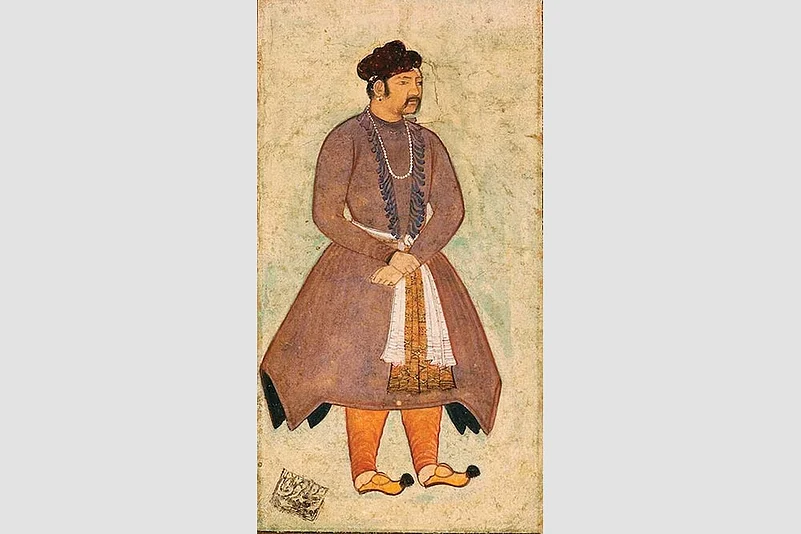We often try to contextualise medieval rulers in today’s world and judge them according to today’s norms. Manimughda Sharma starts Allahu Akbar by viewing Akbar through a modern lens. He begins with 1941, when there was unrest in India, with the growing chasm between the Muslim League and the Congress following the Lahore Resolution, when the country was caught in a feeling of ill-will which eventually led to Partition. A certain Adi K. Munshi of Bombay wrote a letter to the the Times of India (published on October 15, 1941), wishing for peace and communal amity. “He longed for a leader whom he thought could unite the Hindus and Muslims. It was not Mohandas. K. Gandhi, Muhammad Ali Jinnah or Jawaharlal Nehru. It was not Subhas Chandra Bose or Vallabhbhai Patel. It was someone from the glorious past of India. It was Emperor Jalaluddin Mohammad Akbar,” writes Sharma. Munshi called him ‘the greatest Indian nationalist of all time’.
This book examines the reasons for that statement. In the mid-sixteenth century, the young Akbar, who had just become emperor, went on a hunt—a pastime that also kept men battle-ready—near Mathura, birthplace of Lord Krishna. The emperor saw many pilgrims going to the temple. He spent time with the pilgrims, talking to them, trying to understand their problems. He came back and abolished the pilgrimage tax—a tax levied since the 12th century on non-Muslims visiting their place of worship. Akbar felt that levying a tax on someone going to see his god was a sin. This was in 1563, and he was willing to forgo taxes worth crores of rupees (as per Abul Fazl in Akbarnama) at a time when the Mughal Empire was yet to be the world’s richest empire with a quarter of its GDP.
“In simpler words, Akbar meant that he may not believe in a particular religion, but he wouldn’t stop anybody from believing in it. And the state wouldn’t come in between an individual and his faith,” writes Sharma. Later, Akbar abolished jeziya too. This was the start of Mughal polity of a unique blend of syncretism and inclusion.
Sharma’s book comes when Akbar’s image is sought to be maligned and he is set up against Maharana Pratap. Yet, that wasn’t the case back then. Sharma cites 17th century bards who sang of Akbar as Karan and Rana Pratap as Arjun. Even in the Annals and Antiquities of Rajasthan, James Todd, who followed the Mewar kingdom’s views, had largely positive things to say about Humayun and Akbar. After all, Akbar established ties (military and blood) with the Rajputs that lasted for centuries.
Todd tells a story of Rani Karnavati of Chittor (grandmother of Pratap) who sent a rakhi to Humayun, asking for protection. Humayun was in Bengal on an expedition and even though he left it halfway, he could not reach in time—the valiant queen committed jauhar. Humayun ensured that her son was retained on the throne and Bahadur Shah of Gujarat was defeated.
Sharma connects this to 2016, when Baloch activist Karima Baloch sends a rakhi to PM Narendra Modi, who publicly declared his support to the movement in his Independence day speech.
I had asked Sharma why he had named his book thus. He said I would find the answer in the book. I did. The divine right to rule has been used from time immemorial and though Akbar broke all rules, he wasn’t averse to this either. Whether he liked the play on his name or the ambiguity it offered, it was mandatory for the followers of Din e Ilahi to greet each other with ‘Jalle Jalalahu’ and to be replied with ‘Allahu Akbar’. He also used the term ‘Allahu Akbar’ in his imperial seal and coinage. Years later, we see Har Har Modi echoing in the city where Har Har Mahadev is a standard greeting.
Allahu Akbar relates the history of Akbar weaving in and out of countries, time and, indeed, history itself. Its brilliance lies in the fact that Sharma seamlessly connects incidents, events from the past, across countries and regions—giving us a broader canvas on which to understand history, for we seem to learn nothing from it.
A common lesson is learnt from Alexander’s invasion in 324 BC when he crossed the rain-swollen Ravi to give battle to the much larger army of Porus (confident that Porus would not ford the river), to Bairam Khan crossing the Sutlej in similar circumstances to fight Tardi Khan and then Ahmed Shah Abdali crossing the flooded Yamuna to trap the Martha army at Panipat. History favours the brave, especially warrior who takes bold decisions.
The Afghans not only did not cross the river, giving Bairam Khan the tactical advantage of time in 1555, but also accidentally or deliberately set fire to a village near their lines. This illuminated the Afghan ranks and presented a clearer target.
Recently, on a visit to Isfahan, I saw the painting of the reception given by Shah Tahmasp for Humayun, when the latter having lost his empire in India sought refuge in Persia. The first thing I noticed is that Humayun is bent, his hands with open palms seemingly in an outstretched position, his noblemen standing around him, while Shah Tahmasp is sitting straight, regally and his nobles are seated. This same meeting is shown in Akbarnama as a meeting between equals.
“This (in Akbarnama) is nothing but a propaganda painting,” writes Sharma, “giving a positive spin do a humiliating event and that makes it much more topical to examine today.” He compares it to the political campaign in the 2014 general elections, when doctored videos, distortion of facts and morphing of photographs were done (especially on social media) to ‘bump up’ the public image of Modi and other BJP leaders.
The retelling of history, especially today, often contradicts contemporary sources, and Sharma stitches an account for us by comparing various medieval sources with modern histories. It’s a much needed look at an imposing figure and his legacy in today’s context of deepening communal divide and demonisation of a minority community.
Akbar was a rational, open-minded and pragmatic ruler, impulsive at times but blessed with immense physical and moral courage, a man of integrity who seems to belong to Shakespeare’s plays. Not only this, he believed in one universal god and the equality of all religions.
So, next time you see Akbar, don’t think of Prithviraj Kapoor opposing a marriage that he felt was distastefully transcending class barriers. Remember, that he was a leader and statesman in the true sense of the word.
We need an Akbar again: the ruler who established sulh-e kul (universal reconciliation) in India. Till then, we can read Sharma’s book to understand our past through this very well-researched history (the bibliography runs into 18 pages) and not through false, vicious Whatsapp ‘forwards’ aiming to increase communal discord.
(Rana Safvi is an author and historian whose most recent book is Shahjahanabad: The Living City of Old Delhi)
























